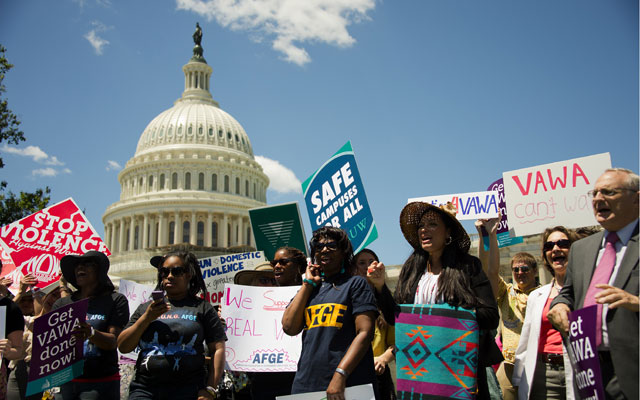“Violence Against Women Act” Gives Grant Money to Misleading Organizations
David B. Muhlhausen /
The National Task Force to End Sexual and Domestic Violence Against Women (NTF), a front group for organizations dependent on the Violence Against Women Act (VAWA) grant funding, recently released a highly flawed and misleading review of why the Violence Against Women Reauthorization Act of 2013 (S. 47) is an effective piece of legislation. The NTF’s “fact sheet” plays fast and loose with the facts about the effectiveness of the VAWA.
The principal reasons for the existence of the VAWA programs are to mitigate, reduce, or prevent the effects and occurrence of domestic violence. Despite being created in 1994, grant programs under the VAWA have not undergone nationally representative, scientifically rigorous experimental evaluations of effectiveness.
The Government Accountability Office (GAO) concluded that previous evaluations of the VAWA programs “demonstrated a variety of methodological limitations, raising concerns as to whether the evaluations will produce definitive results.” Further, the evaluations were not representative of the types of programs funded nationally by the VAWA. In addition to The Heritage Foundation and GAO, others have noted that there is virtually no evidence that the VAWA programs are effective.
To counter the fact that the VAWA programs have never undergone large-scale, scientifically rigorous experimental evaluations of effectiveness, the NTF cites flawed research and ignores inconvenient findings.
First, the NTF claims that “[o]ne study finds that the VAWA has ‘significantly strengthened’ victims’ involvement with criminal justice authorities such as prosecutors and court officers.” The study, conducted by social work professors Hyunkag Cho and Dina J. Wilke of Florida State University, used a weak evaluation design to assess the effectiveness of the VAWA on four outcome measures: domestic violence incident rate (violent crime committed by current or former spouses or boyfriends), rate of reporting incidents to the police, arrest rate, and contact with other authorities, such as prosecutors and court officials.
The study found that “the VAWA act did not appear to have a unique impact on most of the existing trends of domestic violence measured for this study, including the domestic violence incidence rate, rate of reporting to the police, and arrest rate.” This unfortunate finding is conveniently ignored by the NTF.
Despite the study finding that the VAWA had no effect in the majority and most important outcome measures, it did find an increased contact with other authorities, including prosecutors and court officials. However, this finding should be taken with caution, because the evaluation methodology used by the authors failed to control for changes in socioeconomic factors that influence their domestic violence outcomes.
Central to the scientific endeavor of program evaluation is the ability to rule out other explanations for changes in the outcome of interest. For example, the VAWA was enacted during a period of declining crime. Reductions in domestic violence may have as much to do with socioeconomic and other factors as with the efforts of the VAWA-funded programs. Assessments of the VAWA’s effectiveness need to take into account or control for the effects of other factors that may actually explain changes in domestic violence.
While it is correct that domestic violence has declined since 1994, such factors as a growing economy, demographic changes, and increased incarceration of violent offenders may actually be the real reasons for the decline since 1994. Controlling for other factors is crucial for isolating the effect of the VAWA on domestic violence. Cho’s and Wilke’s methodology completely fails to account for any socioeconomic factors, like overall declining crime, that may actually explain changes in their outcome measures. Thus, their study likely overstates the impact of the VAWA on contact with other authorities.
Second, the NTF claims that “other researchers have found that the ‘STOP [Services Training Officers Prosecutors] program has been critical to law enforcement and prosecution training, and the development of specialized units.’” The study they cite is a process evaluation that does not remotely attempt to measure the VAWA’s impact on domestic violence. The authors of the process evaluation did not perform any scientifically rigorous analysis to determine the effectiveness of VAWA on reducing domestic violence.
Third, the NTF claims that a “ 2002 study found that VAWA saved an estimated $14.8 billion in net averted social costs in its first five years alone.” While this finding sounds impressive, the devil is in the details. The NTF refers to a cost-benefit evaluation that makes the dubious assumption that “[a]ll reduction in violent criminal victimization of women after the implementation of VAWA-I was attributed to the VAWA-I program.” This incredulous assumption ignores the fact that other policies and socioeconomic factors influence changes in domestic violence incidents. It would be similarly absurd if prison incarceration advocates assumed that the increased use of prisons explained 100 percent of the decline in crime over the past two decades.
Members of Congress should be weary of special interests, like the NTF, that will say anything to continue raiding the federal treasury.

